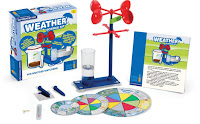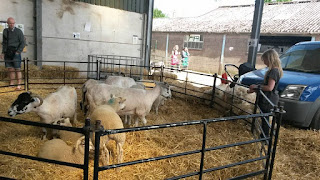 |
| Using sand/cornmeal/flour draw out letters of the alphabet |
Home Education is a holistic approach. Life is learning; the world is your classroom, and we should never adopt the mindset that we might be too old to become inspired. It's wonder and curiosity that spurs us to want to know more and more. The best way to learn is to do, not to be told. A holiday isn't the same experience as looking through the travel guide.
These are some very basic ideas for the younger child who will love, no doubt, to play, so incorporate learning into play. And watch out for 'teachable moments' and be sure not to dismiss them.
Eg: If your child's attention is drawn to something, maybe they like trains or buses; or you point out something unusual or pretty like a butterfly; or use the season or weather to tell them about hibernation or thunderstorms or watch for types of clouds.
 |
| Nature notebooking |
Even
Fairy-stories like Red Riding Hood can be a springboard to learn about wolves (and perhaps take it to include other carnivores) - where they can be found, (this may lead to looking more into the country you have now brought into the mix), what they eat (and not grandma...) - construct a simple food chain, are they endangered (maybe look at conservation) ect. Roll with it and it will soon become an exciting delight-lead project. Pick it apart in every way. It rather like a brainstorming session - one thing leads to another and another. And ALWAYS weave in a way to eat something to do with your studies. (see the project page)
We found some great resources online for weather watching.
Each day record the date and weather and any wildlife or wayside flowers they might see on a walk around where you live. Sketch or paint them in a Nature/Weather Journal. Write a sentence or two. Start a seashell, pebble, collection or
nature table of twigs, leaves and acorns. Or a
colour table - go find anything in the house that is red for example, maybe the child can sort objects by shape or size. Button sorting is a good activity. Perhaps glueing them into patterns or pictures,
 |
| Button art for an under-the-sea project |
If they are too young for real buttons, large colourful buttons can be easily found to buy online. The child can create patterns by threading them onto a lace.
There are many
Scavenger/Treasure Hunts to download or make your own.
Scavenger Hunt Ideas
I remember making a
Book Hunt one time - find a book that is blue/has an animal on/that is about fairies/has no pictures in it ect.
If your child isn't reading yet,
use pictures.
One time I created a scavenger hunt about where the food in our kitchen comes from. Find an item from the Ivory Coast, Seville, the rain forest. We had a laminated world map and I made small laminated pictures to blue-tack to it. The children took clipboards to the supermarket and noted the stickers on the fruit and veg. Inspired by the book The World Came To My Place Today.
With a
treasure hunt, leave a clue (picture or otherwise) hidden in each spot. A die-hard favourite was a
chocolate coin hunt - playing Hot or Cold to hone in on the hidden prizes.
Mystery objects - put some bits and bobs in a pillowcase and let the child guess what they can be eg a toy car, nut, shell, spoon.
 |
| Nature Journal |
Cut out pictures - from a magazine or travel brochure and let the child dictate a story about it if they aren't able to write yet and you be their scribe. The same can be done with
newspaper articles that may be of interest. One of my daughters inspired to be a journalist and so would cut and paste items from the newspapers on to coloured paper, expounding on the article with a sentence or two, and staple them into her own newspaper.
Grow seeds - water them, (Not got a watering can? Poke holes in the lid of an empty milk carton. Handle is already there for you), record the stages of growth in a diary. Peas are especially good as the whole
growth cycle can be observed, (learn about this, find resources online or draw it), but cress and herbs can be just as eagerly tended to, on the window sill. An old CD with some soil in is shallow enough for your child to observe the
root system.
Explore what other countries plant to eat and maybe buy some ingredients together and cook a simple meal. Learn about a farmers calendar, go visit a farm, read books together (both fiction and non-fiction about seeds, and farms and seasons, scarecrows) do crafts and paint about it. - see our projects pages. And before you know it, you have ran with a whole new unit study.
Simple Maths - I'm no expert in child education but this is what I have discovered in the 20 years of HEding. It is evident that we first learn by counting physical objects; toy cars, oranges, stones. Bring in numbers when you think your child is ready to retain a number or two - or more. Then progress onto pictures of items, again include cardinal numbers to illustrate. Then finally the child can progress onto number sums, as we adults see maths to be. There are many, many websites with ideas and worksheets to help your child progress. Don't be tempted to work with numbers if your child hasn't fully grasped the concept and isn't ready to move on. Even if you feel they have been left behind and
should be at that stage. Never skip a stage.
Simple games for Weight, Length, Money and Volume
Length - Hand your child a tape measure or ruler and ask them to measure and record (you can find worksheets online or draught your own) how long things are around the house - the mat, the TV, the cupboard door. Which is tallest, smallest, widest? If you dont have to tape measure, ask them to take pin-steps and estimate/work out how many it will take to walk the length of the hall, bedroom, mat.... Were they correct? Will an adult take as many steps? How come?
Weight - Kitchen
scales can be very absorbing for a child, whether you are baking together or just experimenting (eg. which will weigh more, this apple or that lego brick?) or practising fine motor skills by using a scoop to weigh out ingredients.
 |
Learn to read scales worksheet
|
Make your own scales
Volume - what can be easier than this? Just using kitchen scoops or lids of detergent/softener bottles, small cups, jugs and empty food containers (yoghurt pots for eg) estimate and guess how many of one will fill another. Add a funnel and an old washing up bottle for fun, and every so often to add interest, add bubbles or food colouring to the water.
Money - My children loved to play shop. They had toy money and a till and a toy shopping basket (but you can improvise with real money, pebbles or buttons and a container) We stuck price labels on food items and, they took turns in shopping and giving change. Many worksheets and online activities are available. This can be adapted to larger numbers for older children, with questions such as What can I buy with £5? How many £3 ice creams can I afford with a £10 note, and how much change will I get.
Magnets, and Can it Float? These are fun things to try. Record what is
magnetic around the house. Show the child how to do the magnetic trick. It always goes down well with budding magicians. (Take a piece of A4 and 'secretly' move the magnet underneath, making a paperclip move on top) For older children, there are many experiments online.
 Floatation experiments -
Floatation experiments - use worksheets online or make your own to record the child's' guesses and findings.
Make sailboats -
 |
| Origami animals of Asia |
 |
| Seasons flashcards |
 |
| Making animals from shapes |
Every year in the UK, farms open their premises to educate kids from the towns and cities







































